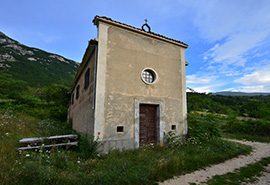San Cataldo lived in the VII century, became a priest and in 637 became abbot of the monastery of Lismore in Ireland and bishop in 670. During one of his visits to the holy land on his knees on the holy sepulchre Jesus Christ appeared to him and invited him to bring Taranto, being threatened by several parties, within the fold of christianity. After a perilous journey Cataldo reached Lecce and went up to Taranto, where he completed the task entrusted to him. Here he died and his remains were placed in the church of San Giovanni in Galilee.
The cult of Saint Cataldo is particularly widespread in southern Italy and more rare in the center and north, so the small church of Palena is an outstanding example. It was built in the XI century when it was mentioned in a letter issued by Pope Clement II (1080-1100). The cult of St. Cataldo was most probably helped to spread from south to central Italy by existing contacts of a commercial nature or related to transhumance, between this mountain area and Puglia.
The church of San Cataldo is presented as a simple building with a single hall, with a small central altar and sacristy at the back. Inside the Church two statues of the saint had been conserved for a long time. One is exhibited in a glass case on the altar, while the other in wood, carved by shepherds was transported to the church of San Falco.
On the 10th May each year the faithful people of Palena gather in this church and drink at the nearby fountain, whose waters are considered curative against malignant fevers.
The fountain, which bears the name of San Cataldo, was built around 1812 to inaugurated the start of the construction of the road Roccaraso-Palena, concluded in 1832.

San Cataldo lived in the VII century, became a priest and in 637 became abbot of the monastery of Lismore in Ireland and bishop in 670. During one of his visits to the holy land on his knees on the holy sepulchre Jesus Christ appeared to him and invited him to bring Taranto, being threatened by several parties, within the fold of christianity. After a perilous journey Cataldo reached Lecce and went up to Taranto, where he completed the task entrusted to him. Here he died and his remains were placed in the church of San Giovanni in Galilee.
The cult of Saint Cataldo is particularly widespread in southern Italy and more rare in the center and north, so the small church of Palena is an outstanding example. It was built in the XI century when it was mentioned in a letter issued by Pope Clement II (1080-1100). The cult of St. Cataldo was most probably helped to spread from south to central Italy by existing contacts of a commercial nature or related to transhumance, between this mountain area and Puglia.
The church of San Cataldo is presented as a simple building with a single hall, with a small central altar and sacristy at the back. Inside the Church two statues of the saint had been conserved for a long time. One is exhibited in a glass case on the altar, while the other in wood, carved by shepherds was transported to the church of San Falco.
On the 10th May each year the faithful people of Palena gather in this church and drink at the nearby fountain, whose waters are considered curative against malignant fevers.
The fountain, which bears the name of San Cataldo, was built around 1812 to inaugurated the start of the construction of the road Roccaraso-Palena, concluded in 1832.